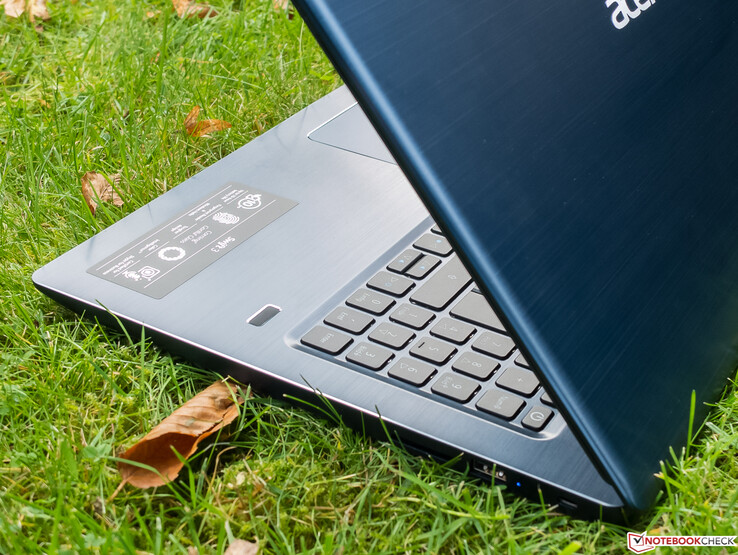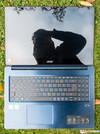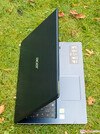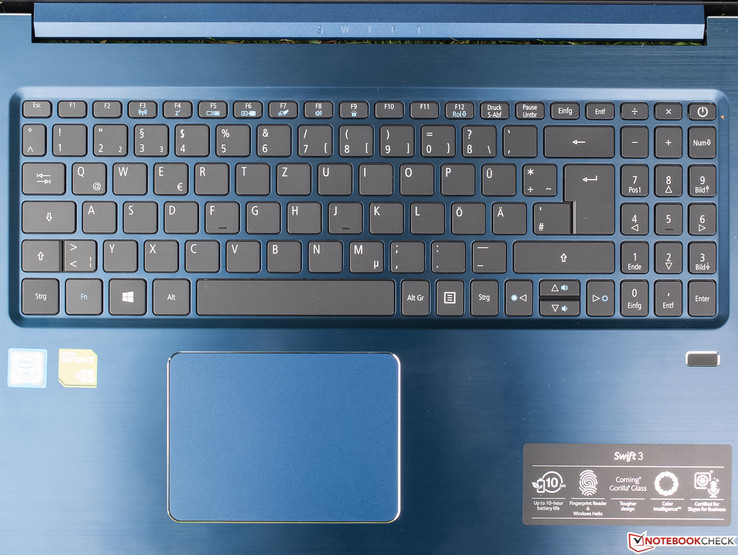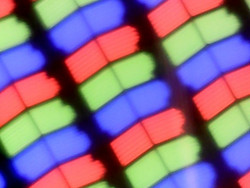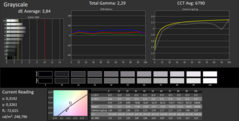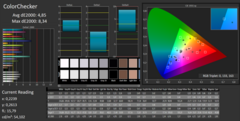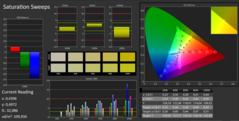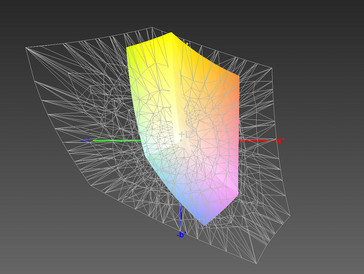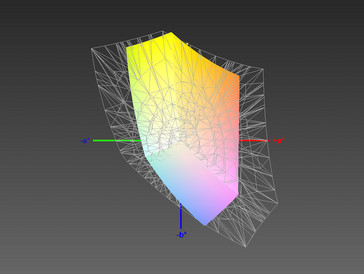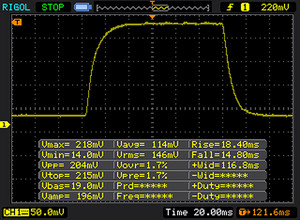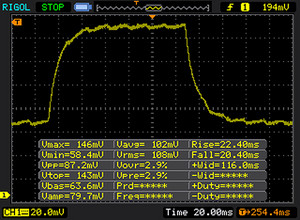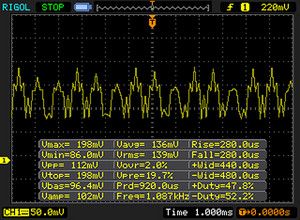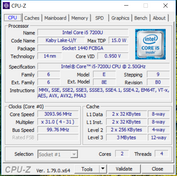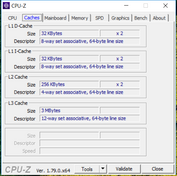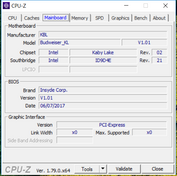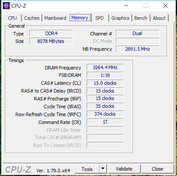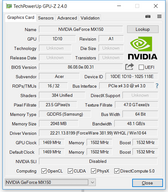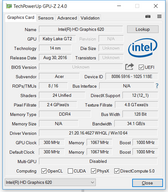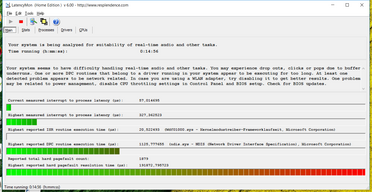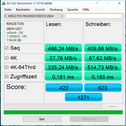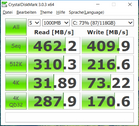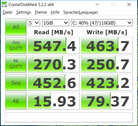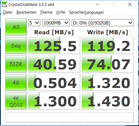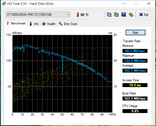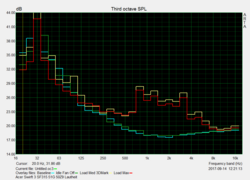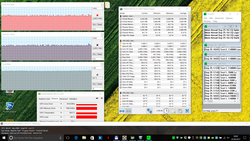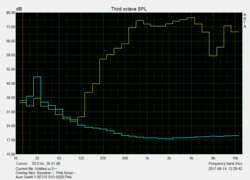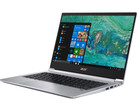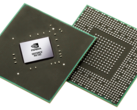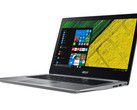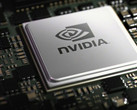Acer Swift 3 SF315 (i5-7200U, GeForce MX150) Laptop Review

For the original German review, see here.
The new Acer Swift 3 SF315-51G-55Z9 is a compact multimedia notebook with a ULV dual-core processor, the new Nvidia GeForce MX150, 8 GB RAM, and IPS Full HD display. The device is also suitable for mobile office use and can handle more demanding software without any problems, thanks to the security features and a good battery life. In addition to the 128-GB system SSD, there is also a conventional hard drive with a 1-TB capacity. Windows 10 Home is preinstalled.
In an extensive price comparison in Berlin, we found eight variants of the Swift 3 SF315-51G for prices between 900 and 1500 Euros (~$1057 - $1762; in the US between $800 and $1700) at the time of testing, which were all different in terms of their CPU (for example i5-8250U), storage, and hard drive, but they all had Windows 10 Home, the MX150, and the same screen. In terms of the color, silver, anthracite, and blue are available, but this does not mean that each model is available in every color, though.
As comparison devices, we selected three 15-inch multimedia notebooks in a similar price range, although some of them have considerably more powerful hardware in form of the i7-7700HQ and the GeForce GTX 1050 (Ti):
- Asus FX553VD-DM249T
- Lenovo ThinkPad E570-20H6S00000
- Acer Aspire VX5-591G-75C4 VX15
Case
Acer provides its newbie with a metal case, which in the case of our test unit is in midnight blue. The top of the base and the lid have a brushed-metal finish which makes fingerprints stand out and really hard to remove, if possible at all, so that they look quite unattractive.
This is unfortunate, since we actually like the design. Acer put neat silver edges around the base, the touchpad, and the fingerprint scanner. These form the visual highlights, together with the edgy hinge typical for Acer and the silver Acer lettering on the back. Unfortunately, the edge of the base is somewhat sharp, even though this did not lead to any ergonomic problems during the test.
Despite the use of metal, it does not take much force to twist the base to some extent. This produces unattractive but harmless-sounding creaking noises. The lack of a notch makes the device slightly difficult to open and if you don't keep it down with the other hand, the base comes up as well when you try to lift the lid. On the other hand, the lid does not bounce much after jerky movements. It can only be warped to a limited extent, and if you press on the back, you can see distortions in the image in front. The base appears solid but can be easily depressed in the center above the keyboard.
In terms of the workmanship, all is in best order. The few case parts were assembled cleanly, and we did not notice any overhanging edges or irregular gaps.
"Swift 3 Ultraslim" is the slogan on Acer's website of the Swift 3 SF315-51G. Compared to the other devices in the test (15.6-inch), this is absolutely true. The test unit has the smallest footprint as well as the lowest thickness and weight. Particularly in comparison to the quite large, thick, and hefty Acer Aspire VX5, our Swift 3 appears very compact. However, in light of the considerably more powerful hardware (i7-7700HQ, GTX 1050 Ti), the VX5 has more need for cooling. The same also goes for the Asus FX553VD, which takes up slightly less room than the VX5, but is the thickest of the devices.
Features
"Standard fare plus USB Type-C" - this could best describe the connection equipment. Right-handed people will thank Acer for positioning the only USB-2.0 port, which is intended for an external mouse, sensibly far back on the right side. Next to it is just the card reader, from which half of the SD card will still stick out, and the opening for the Kensington lock. In this way, there can be no collisions between cables and USB sticks. The USB 3.0, HDMI, and audio ports are in the back area of the left side. Acer deserves praise for this almost ideal positioning of the ports.
SD-Card Reader
Acer remains faithful to their preference for very slow card readers and equips the Swift 3 SF315-51G with a reader that is slow even for its measly USB-2.0 connection. In contrast, Asus and Lenovo have a heart for photographers and have equipped their competitors at least with a USB-3.0 connection. As always, we measured the transfer rates with our Toshiba Exceria Pro SDXC 64 GB UHS-II reference storage card.
| SD Card Reader | |
| average JPG Copy Test (av. of 3 runs) | |
| Asus FX553VD-DM249T (Toshiba Exceria Pro SDXC 64 GB UHS-II) | |
| Lenovo ThinkPad E570-20H6S00000 (Toshiba Exceria Pro SDXC 64 GB UHS-II) | |
| Acer Swift 3 SF315-51G-55Z9 (Toshiba Exceria Pro SDXC 64 GB UHS-II) | |
| Acer Aspire VX5-591G-75C4 VX15 | |
| maximum AS SSD Seq Read Test (1GB) | |
| Asus FX553VD-DM249T (Toshiba Exceria Pro SDXC 64 GB UHS-II) | |
| Lenovo ThinkPad E570-20H6S00000 (Toshiba Exceria Pro SDXC 64 GB UHS-II) | |
| Acer Aspire VX5-591G-75C4 VX15 | |
| Acer Swift 3 SF315-51G-55Z9 (Toshiba Exceria Pro SDXC 64 GB UHS-II) | |
Communication
Even though it is not very up-to-date anymore, thanks to the Intel Dual Band Wireless-AC 7265 MIMO-2x2 module with Bluetooth 4.2 (possibly a driver update might be necessary), the Acer Swift 3 achieves standard IEEE-802.11ac speeds in the 5-GHz band during sending and receiving. Of the theoretical gross data rate of 867 MBit/s, about 200 MBit/s is regularly used for the overhead. Except for the ThinkPad, the competitors in the test all use the same model as our test unit and also have the same speed, while the Qualcomm-Atheros module in the Lenovo clearly falls behind particularly during sending.
Security
The Acer Swift 3 SF315-51G-55Z0 has a fingerprint-sensor for placing your finger. After a slightly hairy setup procedure with Windows Hello, the laptop could be unlocked quickly and reliably with it. A Trusted Platform Module (TPM) version 2.0 is also included.
Accessories
Besides the required power supply, only the customary setup and warranty instructions are in the box. Acer does not offer any accessories designed specifically for the Swift 3. On the web page under "Purchase together with this," you can take a look at several universally usable accessories such as a USB Type-C to HDMI adapter and warranty extensions subject to charge.
Maintenance
Some maintenance tasks might turn out to be difficult, since there is no maintenance flap and the bottom of the case is flush with the top of the base, so that after having removed 12 Torx screws, you might only get access to the insides, including the battery, from the top.
Warranty
Acer offers a two-year send-back warranty. The company also offers warranty extensions for purchase. Please see our Guarantees, Return Policies & Warranties FAQ for country-specific information.
Input Devices
Keyboard
The width of the main section of the keyboard is exactly the same as that of a standard desktop keyboard. The key sizes and distances have standard measurements, while the number pad turned out much too small with only three columns and a layout that therefore takes some getting used to.
With a medium stroke, after a not very pronounced pressure point there follows a light stop, which is just the way the tester likes it and is clearly audible with both the large and small keys. All the keys are completely flat, flawlessly labeled, and can be illuminated sufficiently and very evenly. However, the backlight has only one step. In the center area the keyboard can be pressed down slightly, but only with some intentional effort. While it is by no means a top-end keyboard as you can find, for example, in Lenovo's ThinkPad series, in our opinion there is nothing preventing you from using it for longer writing tasks.
Touchpad
Acer uses the space well and has equipped the Swift 3 SF315-51G with a large ClickPad with a silver frame and without separate keys. The sleek surface allows smooth sliding of even moist fingers. The precision and response characteristics are flawless, and even fast movements are followed correctly. Drag and drop via double tap also works fine. Gestures with up to four fingers can "only" be configured via Windows 10 settings.
The mouse keys at the bottom area of the ClickPad have a rather short stroke and convince with their well-adjusted resistance and clear pressure point with flawless acoustic feedback.
Display
Unfortunately, Acer has chosen a reflective IPS display with a 15.6-inch diagonal in Full HD resolution, which appears razor-sharp, despite its mediocre 141 ppi. Like the competitors in the test, the average brightness of 239 cd/m² is too low, and in a 1000-Euro (~$1175) laptop we expect at least 300 cd/m².
The brightness distribution is unusually uneven. 69% is the worst value our tester has seen in all their years at Notebookcheck. As often, this is difficult to verify subjectively, and the black image, which appears quite saturated, makes a homogeneous impression, with only some beginnings of screen-bleeding visible at the lower edge. Acer does not offer any alternative display variants in this series.
| |||||||||||||||||||||||||
Brightness Distribution: 69 %
Center on Battery: 252 cd/m²
Contrast: 1378:1 (Black: 0.18 cd/m²)
ΔE ColorChecker Calman: 4.85 | ∀{0.5-29.43 Ø4.78}
ΔE Greyscale Calman: 3.84 | ∀{0.09-98 Ø5}
57% sRGB (Argyll 1.6.3 3D)
37% AdobeRGB 1998 (Argyll 1.6.3 3D)
40.31% AdobeRGB 1998 (Argyll 3D)
57.7% sRGB (Argyll 3D)
39.02% Display P3 (Argyll 3D)
Gamma: 2.29
CCT: 6790 K
| Acer Swift 3 SF315-51G-55Z9 BOE0700 / BOE CQ NV156FHM-N48, , 1920x1080, 15.6" | Asus FX553VD-DM249T BOE, , 1920x1080, 15.6" | Acer Aspire VX5-591G-75C4 VX15 LG Philips LGD0550 / LP156WF6-SPK4, , 1920x1080, 15.6" | Lenovo ThinkPad E570-20H6S00000 AUO B156HAN04.4, , 1920x1080, 15.6" | |
|---|---|---|---|---|
| Display | -2% | 0% | -0% | |
| Display P3 Coverage (%) | 39.02 | 37.98 -3% | 38.88 0% | 38.65 -1% |
| sRGB Coverage (%) | 57.7 | 57.1 -1% | 58.2 1% | 58 1% |
| AdobeRGB 1998 Coverage (%) | 40.31 | 39.24 -3% | 40.2 0% | 39.94 -1% |
| Response Times | 32% | 38% | 7% | |
| Response Time Grey 50% / Grey 80% * (ms) | 42 ? | 43 ? -2% | 22 ? 48% | 44.8 ? -7% |
| Response Time Black / White * (ms) | 32 ? | 11 ? 66% | 23 ? 28% | 25.6 ? 20% |
| PWM Frequency (Hz) | 1087 ? | |||
| Screen | -14% | -10% | -5% | |
| Brightness middle (cd/m²) | 248 | 225 -9% | 281 13% | 242 -2% |
| Brightness (cd/m²) | 239 | 215 -10% | 257 8% | 243 2% |
| Brightness Distribution (%) | 69 | 91 32% | 85 23% | 75 9% |
| Black Level * (cd/m²) | 0.18 | 0.46 -156% | 0.32 -78% | 0.24 -33% |
| Contrast (:1) | 1378 | 489 -65% | 878 -36% | 1008 -27% |
| Colorchecker dE 2000 * | 4.85 | 3.94 19% | 5.16 -6% | 4.65 4% |
| Colorchecker dE 2000 max. * | 8.34 | 6.83 18% | 9.09 -9% | 9.64 -16% |
| Greyscale dE 2000 * | 3.84 | 2.68 30% | 4.57 -19% | 3.39 12% |
| Gamma | 2.29 96% | 2.35 94% | 2.59 85% | 2.7 81% |
| CCT | 6790 96% | 6709 97% | 6931 94% | 6246 104% |
| Color Space (Percent of AdobeRGB 1998) (%) | 37 | 36 -3% | 37 0% | 36.69 -1% |
| Color Space (Percent of sRGB) (%) | 57 | 57 0% | 58 2% | 57.66 1% |
| Total Average (Program / Settings) | 5% /
-6% | 9% /
-2% | 1% /
-3% |
* ... smaller is better
Thanks to the lowest black value of the competition in the test at 0.18 cd/m², the Swift 3 achieves a very good contrast of 1378:1 despite the low brightness, thus setting it clearly apart from the competitors which suffer from higher black values, as in the case of the Asus FX553VD (contrast: 489:1) in particular.
While with Delta-E values of 5 (ColorChecker) and 4 (grayscales), the color display of the Swift 3 is not too far from the ideal values of 3 or less already in the delivery state, all the notebooks mess up in the test with the displayable color range. Coverage of the smaller sRGB color space of only 57 or 58% eliminates any ambitions for image-processing, even by amateurs. At least you cannot expect any usable results. Since our calibration and profiling with the CalMAN software and a photo spectrometer failed, unfortunately we cannot provide a link for an ICC profile at this time. However, our test unit does not have a visible tint in the delivery state.
Since the display is reflective and not particularly bright, it is difficult to impossible to escape the ever-present reflections outdoors, even in the easier conditions of a cloudy day. Even in an almost ideal position with the entry of a house in the back (right photo), you can still see annoying reflections, but work is still possible.
Display Response Times
| ↔ Response Time Black to White | ||
|---|---|---|
| 32 ms ... rise ↗ and fall ↘ combined | ↗ 18 ms rise | |
| ↘ 14 ms fall | ||
| The screen shows slow response rates in our tests and will be unsatisfactory for gamers. In comparison, all tested devices range from 0.1 (minimum) to 240 (maximum) ms. » 85 % of all devices are better. This means that the measured response time is worse than the average of all tested devices (20.2 ms). | ||
| ↔ Response Time 50% Grey to 80% Grey | ||
| 42 ms ... rise ↗ and fall ↘ combined | ↗ 22 ms rise | |
| ↘ 20 ms fall | ||
| The screen shows slow response rates in our tests and will be unsatisfactory for gamers. In comparison, all tested devices range from 0.165 (minimum) to 636 (maximum) ms. » 66 % of all devices are better. This means that the measured response time is worse than the average of all tested devices (31.6 ms). | ||
Screen Flickering / PWM (Pulse-Width Modulation)
| Screen flickering / PWM detected | 1087 Hz | ≤ 90 % brightness setting | |
The display backlight flickers at 1087 Hz (worst case, e.g., utilizing PWM) Flickering detected at a brightness setting of 90 % and below. There should be no flickering or PWM above this brightness setting. The frequency of 1087 Hz is quite high, so most users sensitive to PWM should not notice any flickering. In comparison: 53 % of all tested devices do not use PWM to dim the display. If PWM was detected, an average of 8101 (minimum: 5 - maximum: 343500) Hz was measured. | |||
In general, IPS displays offer a lot of freedom of movement with stable colors. Devices that are really good in terms of viewing-angle stability only show the unavoidable loss of brightness and contrast from very steep viewing angles. This is not the case for our test unit, which shows darkening already at less than a 45-degree angle.
Processor
The current Core i5-7200U is probably the most widely used Intel Kaby-Lake ULV processor, which is often encountered in office or business and multimedia notebooks in particular. Thanks to its two cores with Hyper-Threading and a basic clock speed of 2.5 GHz to 3.1 GHz (Turbo), it handles even the most demanding tasks without any complaints, but it is less suitable for demanding games, which often profit considerably from four or more physical cores. The CPU integrates Intel HD Graphics 620 and a DDR4-RAM controller and is suited for very compact and flat laptops, thanks to its TDP of only 15 watts.
The single and multi-core performance is on the expected levels and is almost identical with that of the ThinkPad E570's with the same CPU. Due to its higher clock speed, the i7-7700HQ (4x 2.8 - 3.8 GHz, Hyper-Threading, TDP 45 W) in the two other comparison devices achieves a slightly better score in the single-core benchmark of Cinebench R15 and is able to fully use the power of its four cores with eight threads in the multi-core benchmark. As you can see in the results of our CB-15 multi-core loop, the performance remains the same even under constant load, which can only lead to the conclusion that the 2-core Turbo or 3.1 GHz is optimally used. Away from the power grid, the performance does not change.
System Performance
For our measurement of the system performance we use PCMark 8 again, which does not put too much stake in the GPU performance, as is well known. The first thing we see is that all the laptops in the tests are very close in their test scores with differences of at most 13%, so that the differences in practice should be very limited. The bad results of the Acer Aspire VX5-591G can be traced back to its HDD, and the first places of the Asus FX553VD can be attributed to its combination of quad-core CPU and SSD.
Subjectively, the performance conforms to the good PCMark results, and the operation is almost always very smooth.
| PCMark 8 | |
| Home Score Accelerated v2 | |
| Asus FX553VD-DM249T | |
| Acer Swift 3 SF315-51G-55Z9 | |
| Acer Aspire VX5-591G-75C4 VX15 | |
| Lenovo ThinkPad E570-20H6S00000 | |
| Work Score Accelerated v2 | |
| Asus FX553VD-DM249T | |
| Lenovo ThinkPad E570-20H6S00000 | |
| Acer Swift 3 SF315-51G-55Z9 | |
| Acer Aspire VX5-591G-75C4 VX15 | |
| PCMark 8 Home Score Accelerated v2 | 3719 points | |
| PCMark 8 Work Score Accelerated v2 | 4577 points | |
Help | ||
Storage Solution
Acer has equipped the Swift 3 SF315 with a typical SATA-III SSD from Kingston with 128 GB, which has a much better write performance than the Hynix model in the Asus FX553VD. In the ThinkPad E570, Lenovo chose a Toshiba SSD which is superior in every area, and in some massively so, since it is connected via PCIe. The SSDs wipe the floor with the conventional hard drive in the Acer Aspire VX5-591G.
The read and write performance of the Acer is consistently on a good level for SATA-III, even if it is not excellent. What mainly matters in practice is that it is an SSD. In addition, there is also a 5400-rpm 1-TB HDD on board, which achieved decent results in the benchmarks.
| Acer Swift 3 SF315-51G-55Z9 Kingston RBUSNS8180DS3128GH | Asus FX553VD-DM249T Hynix HFS128G39TND | Acer Aspire VX5-591G-75C4 VX15 Toshiba MQ01ABD100 | Lenovo ThinkPad E570-20H6S00000 Toshiba THNSF5256GPUK | |
|---|---|---|---|---|
| CrystalDiskMark 3.0 | -11% | -91% | 81% | |
| Read Seq (MB/s) | 462.2 | 504 9% | 101.5 -78% | 1140 147% |
| Write Seq (MB/s) | 409.9 | 136.2 -67% | 100.6 -75% | 468.1 14% |
| Read 512 (MB/s) | 310.3 | 340.9 10% | 28.33 -91% | 759 145% |
| Write 512 (MB/s) | 216.6 | 136.9 -37% | 28.31 -87% | 414 91% |
| Read 4k (MB/s) | 31.89 | 29.74 -7% | 0.327 -99% | 34.3 8% |
| Write 4k (MB/s) | 73.2 | 76.8 5% | 0.846 -99% | 123.4 69% |
| Read 4k QD32 (MB/s) | 287.9 | 348.2 21% | 0.718 -100% | 530 84% |
| Write 4k QD32 (MB/s) | 170.6 | 136.4 -20% | 0.893 -99% | 319.2 87% |
Graphics Card
With the new Pascal-based GeForce MX150 (Laptop GT 1030, GP-108 chip), Nvidia has finally introduced into the market the long-anticipated successor of the widely used but now outdated GeForce 940MX, which could or can often be found in multimedia laptops. The standard storage is 2 GB of GDDR5-VRAM with an effective clock speed of 6000 MHz. Fortunately, there is no DDR3 variant anymore, as in the 940MX. As in the slightly more economic predecessor, the 64-bit storage interface is the bottleneck. However, the MX150 can still best even the older GeForce GTX 950M (128-bit).
Our chart below shows the typical differences between the usual mid-range GPUs in the 3DMarks, up to the GTX 1050 Ti which beats the MX150 by up to 119%. Battery operation has no influence on the overall score of the Fire-Strike benchmark.
| 3DMark 11 - 1280x720 Performance GPU | |
| Acer Aspire VX5-591G-75C4 VX15 | |
| Asus FX553VD-DM249T | |
| Acer Swift 3 SF315-51G-55Z9 | |
| Lenovo ThinkPad E570-20H6S00000 | |
| 3DMark | |
| 1280x720 Cloud Gate Standard Graphics | |
| Acer Aspire VX5-591G-75C4 VX15 | |
| Asus FX553VD-DM249T | |
| Lenovo ThinkPad E570-20H6S00000 | |
| Acer Swift 3 SF315-51G-55Z9 | |
| 1920x1080 Fire Strike Graphics | |
| Acer Aspire VX5-591G-75C4 VX15 | |
| Asus FX553VD-DM249T | |
| Acer Swift 3 SF315-51G-55Z9 | |
| Lenovo ThinkPad E570-20H6S00000 | |
| 3DMark 11 Performance | 4507 points | |
| 3DMark Cloud Gate Standard Score | 9757 points | |
| 3DMark Fire Strike Score | 3104 points | |
Help | ||
Gaming Performance
In contrast to the old 940MX, the MX150 represents a clear improvement compared to CPU graphics such as the Intel HD 620. It enables medium presets at 1366x768 pixels even in many of the current games such as the fancy Rise of the Tomb Raider. Less demanding games such as Rocket League even run smoothly in high settings and Full HD, while in other top games such as Ghost Recon Wildlands or PUBG you are again limited to lower presets at 1280x720 pixels.
| low | med. | high | ultra | |
|---|---|---|---|---|
| Rise of the Tomb Raider (2016) | 42.3 | 21.8 | ||
| Rocket League (2017) | 68.8 | 43.2 | ||
| Playerunknown's Battlegrounds (PUBG) (2017) | 71.4 | 27.2 |
Emissions
Noise emissions
As can be gathered from the very good results, the Swift 3 is a very quiet companion. In idle operation the fan is sometimes active and sometimes turned off, but from a half-meter distance you cannot discern it from the surrounding sounds in a quiet single office with a PC running. The hard drive can also only be heard when you are very close to it. The occasional peak loads that happen, for example during web-surfing, do not change anything about it being actually very quiet.
After we begin the stress test (Prime95 + FurMark), the fan revs up and quickly reaches its maximum speed. Now there is some discreet whirring, which is unfortunately accompanied by some high-pitched noises. However, in light of the low overall noise level, the potential for disturbances is limited.
Noise level
| Idle |
| 30.6 / 30.6 / 30.6 dB(A) |
| Load |
| 36.9 / 36 dB(A) |
 | ||
30 dB silent 40 dB(A) audible 50 dB(A) loud |
||
min: | ||
Temperature
While the surface temperatures are generally no issue during idle operation, we measured a not very impressive maximum of 43 °C (109 °F) on the front of the Acer Swift 3 SF315 during constant load - but that is only in the center, right under the screen, where you do not touch for long. On the bottom, it only heats up to a maximum of 37 °C (99 °F), so that there is no obstacle to gaming with the laptop on your lap.
In the stress test with Prime95 + FurMark, the CPU cannot maintain its Turbo of 3.1 GHz for long. As long as the "Performance" or "Balanced" power plans are selected, Turbo is always used in mains operation even without load. It drops to about 2.7 GHz on average, so that the Turbo is not optimally used in this not very relevant scenario, but there is also no throttling either. For a few minutes, the GPU moves within the range of its clock-speed spectrum, before it throttles to 810 MHz and only rarely reaches higher speeds. These observations underline the flawless benchmarks of the MX150, and in practice, we do not expect any throttling during gaming.
(±) The maximum temperature on the upper side is 42.6 °C / 109 F, compared to the average of 36.9 °C / 98 F, ranging from 21.1 to 71 °C for the class Multimedia.
(+) The bottom heats up to a maximum of 37.2 °C / 99 F, compared to the average of 39.2 °C / 103 F
(+) In idle usage, the average temperature for the upper side is 24.7 °C / 76 F, compared to the device average of 31.3 °C / 88 F.
(+) The palmrests and touchpad are reaching skin temperature as a maximum (34.9 °C / 94.8 F) and are therefore not hot.
(-) The average temperature of the palmrest area of similar devices was 28.7 °C / 83.7 F (-6.2 °C / -11.1 F).
Speakers
At a decent volume, the sound becomes quite tinny with mids and highs overemphasized as usual. In addition, the sharp and shrill highs of many music titles are annoying. But at least there is a certain presence, dynamic, and spaciousness. At high volumes, there can be some slight distortions and/or considerable volume fluctuations.
The sound system is completely overwhelmed by high-volume Metal music (Pantera: "Mouth for War"), which leads to a shrill, flat, and muddy sound reproduction. The sound system does not do justice to the multimedia ambitions and also the price of the notebook, and we recommend the use of headphones to gamers. Besides those offered by Windows, we could not find any configuration options.
Acer Swift 3 SF315-51G-55Z9 audio analysis
(±) | speaker loudness is average but good (77.5 dB)
Bass 100 - 315 Hz
(-) | nearly no bass - on average 27.8% lower than median
(±) | linearity of bass is average (11.1% delta to prev. frequency)
Mids 400 - 2000 Hz
(+) | balanced mids - only 4.4% away from median
(+) | mids are linear (5.1% delta to prev. frequency)
Highs 2 - 16 kHz
(±) | higher highs - on average 6% higher than median
(±) | linearity of highs is average (7.2% delta to prev. frequency)
Overall 100 - 16.000 Hz
(±) | linearity of overall sound is average (20.8% difference to median)
Compared to same class
» 70% of all tested devices in this class were better, 8% similar, 22% worse
» The best had a delta of 5%, average was 17%, worst was 45%
Compared to all devices tested
» 56% of all tested devices were better, 8% similar, 37% worse
» The best had a delta of 4%, average was 24%, worst was 134%
Acer Aspire VX5-591G-75C4 VX15 audio analysis
(±) | speaker loudness is average but good (73 dB)
Bass 100 - 315 Hz
(-) | nearly no bass - on average 15% lower than median
(±) | linearity of bass is average (10.7% delta to prev. frequency)
Mids 400 - 2000 Hz
(+) | balanced mids - only 1.9% away from median
(+) | mids are linear (5.9% delta to prev. frequency)
Highs 2 - 16 kHz
(+) | balanced highs - only 4.8% away from median
(+) | highs are linear (2.2% delta to prev. frequency)
Overall 100 - 16.000 Hz
(+) | overall sound is linear (14.8% difference to median)
Compared to same class
» 33% of all tested devices in this class were better, 5% similar, 63% worse
» The best had a delta of 5%, average was 17%, worst was 45%
Compared to all devices tested
» 19% of all tested devices were better, 4% similar, 77% worse
» The best had a delta of 4%, average was 24%, worst was 134%
Lenovo ThinkPad E570-20H6S00000 audio analysis
(±) | speaker loudness is average but good (80.7 dB)
Bass 100 - 315 Hz
(-) | nearly no bass - on average 16.8% lower than median
(-) | bass is not linear (16.4% delta to prev. frequency)
Mids 400 - 2000 Hz
(±) | higher mids - on average 5.1% higher than median
(±) | linearity of mids is average (9.5% delta to prev. frequency)
Highs 2 - 16 kHz
(+) | balanced highs - only 2.7% away from median
(+) | highs are linear (6.5% delta to prev. frequency)
Overall 100 - 16.000 Hz
(±) | linearity of overall sound is average (19.6% difference to median)
Compared to same class
» 62% of all tested devices in this class were better, 8% similar, 30% worse
» The best had a delta of 5%, average was 17%, worst was 45%
Compared to all devices tested
» 48% of all tested devices were better, 7% similar, 44% worse
» The best had a delta of 4%, average was 24%, worst was 134%
Frequency comparison (checkboxes selectable!)
Power Management
Power Consumption
Since the components of the Acer Swift 3 and the Lenovo ThinkPad E570 use a similar amount of power (both i5-7200U, MX150 <-> 950M), they also reach a similar overall power consumption, with the ThinkPad being slightly more efficient in idle mode. With its quad-core and the GTX 1050, our Asus has slightly more power-hungry hardware. However, it profits from Nvidia Optimus, which was deactivated in the Acer Aspire VX5 (i7-7700HQ, GTX 1050 Ti), which uses G-sync instead, leading to the highest overall consumption by far. Under load, the 65-W power supply reaches its limits.
| Off / Standby | |
| Idle | |
| Load |
|
Key:
min: | |
| Acer Swift 3 SF315-51G-55Z9 i5-7200U, GeForce MX150, Kingston RBUSNS8180DS3128GH, IPS, 1920x1080, 15.6" | Asus FX553VD-DM249T i7-7700HQ, GeForce GTX 1050 Mobile, Hynix HFS128G39TND, TN, 1920x1080, 15.6" | Acer Aspire VX5-591G-75C4 VX15 i7-7700HQ, GeForce GTX 1050 Ti Mobile, Toshiba MQ01ABD100, IPS, 1920x1080, 15.6" | Lenovo ThinkPad E570-20H6S00000 i5-7200U, GeForce GTX 950M, Toshiba THNSF5256GPUK, IPS LED, 1920x1080, 15.6" | |
|---|---|---|---|---|
| Power Consumption | -31% | -74% | 6% | |
| Idle Minimum * (Watt) | 3.7 | 4 -8% | 7 -89% | 2.8 24% |
| Idle Average * (Watt) | 6.2 | 6.7 -8% | 10.2 -65% | 6.3 -2% |
| Idle Maximum * (Watt) | 8.4 | 9.6 -14% | 14 -67% | 6.9 18% |
| Load Average * (Watt) | 50 | 81 -62% | 78 -56% | 51.6 -3% |
| Load Maximum * (Watt) | 65.2 | 107 -64% | 127 -95% | 69.7 -7% |
| Witcher 3 ultra * (Watt) | 90 |
* ... smaller is better
Battery Life
The Lenovo ThinkPad E570 has a similar power usage as our test unit, but it has a slightly smaller battery, which reflects in the 8% shorter runtime. Due to the different hardware, a comparison with the two other laptops in the test is not very useful. If we search for 15.6-inch notebooks with an i5-7200U and SSD in our database and limit ourselves to the practically relevant WLAN-test (how we test), we can attest the Swift 3 with an above average endurance. Eight-and-a-half hours with medium brightness does not offer a lot of reserves but should get most users through the workday.
| Acer Swift 3 SF315-51G-55Z9 i5-7200U, GeForce MX150, 49 Wh | Asus FX553VD-DM249T i7-7700HQ, GeForce GTX 1050 Mobile, 48 Wh | Acer Aspire VX5-591G-75C4 VX15 i7-7700HQ, GeForce GTX 1050 Ti Mobile, 52.5 Wh | Lenovo ThinkPad E570-20H6S00000 i5-7200U, GeForce GTX 950M, 41 Wh | |
|---|---|---|---|---|
| Battery runtime | -42% | -49% | -7% | |
| Reader / Idle (h) | 15.3 | 9.8 -36% | 5.4 -65% | 14.7 -4% |
| WiFi v1.3 (h) | 8.5 | 6 -29% | 5 -41% | 7.7 -9% |
| Load (h) | 2.4 | 0.9 -62% | 1.4 -42% | 2.2 -8% |
Verdict
Pros
Cons

If you consider the high price of currently about 950 Euros (~$1116) of the new Acer Aspire Swift 3 SF315-51G-55Z9, only the sub-optimal display - which is by no means terrible - and in particular the pretty bad sound of the newcomer are below the price point. Visually, everything would be great, if it weren't for those pesky and hard-to-clean fingerprints. But maybe the device looks good again after you have really touched it everywhere.
If you disregard the surfaces, the case scores with relatively small dimensions and a limited weight, thus differentiating itself from a good part of the competition. There is also nothing to complain about the workmanship. Thanks to good to very good input devices, TPM, fingerprint-sensor, and a decent endurance, the light, compact, quiet, and cool Swift 3 is very well-suited for mobile office use. Last but not least, with the new Nvidia GeForce MX150, there is finally a usable successor of the aged 940MX leftover card on board, so that casual gaming is possible with good or at least acceptable visuals.
With the new Swift 3, Acer brings an overall successful jack-of-all-trades with gaming ambitions to the market, which will surely find some buyers with the combination of a compact and light case and security features, even though it is not free from weaknesses.
Acer Swift 3 SF315-51G-55Z9
- 10/04/2017 v6 (old)
Sven Kloevekorn




